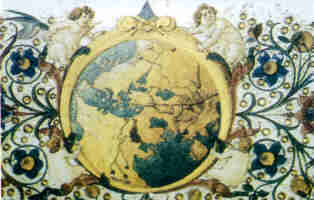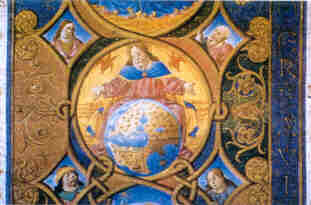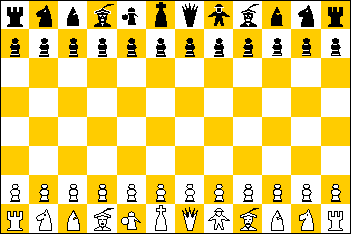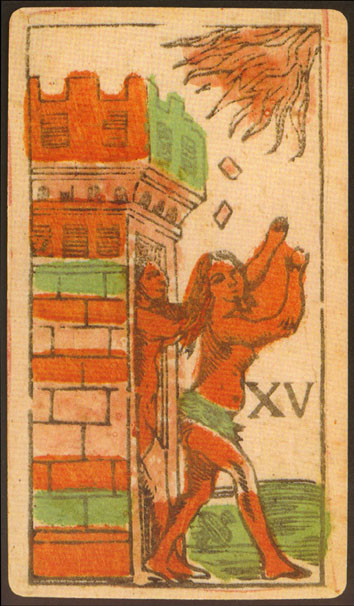mikeh wrote: I am not assuming that the images in the CY are specific to Milan, except of course the heraldics). We might also imagine that I have been told that this a game of Triumphs. From that perspective, they naturally fall into three groups:
5 of the 7 Petrarchan Triumphs
5 of the 7 Cardinal + Theological Virtues
Emperor.
... :-) ...
I guess it are ...
5 of the 6 Petrarca Triumphs
4 of the 7 Cardinal + Theological Virtues
Empress, Emperor.
And for the Chess Tarot theory I see:
Pawns = 7 virtues + LOVE as pawn before the Queen
Rooks = FAME + Judgment (also ETERNITY)
Knights = DEATH + Chariot (also CHASTITY)
Bishops = (perhaps TIME; perhaps hermit and traitor or Fool)
Queen = Empress (also CHASTITY)
King = Emperor (also ETERNITY)
Bishop explanations:
In France the Bishop was called Fou.
In the exotic Courier chess (very old) an "old man" and a "Schleich" (= Fool) were positioned near to King and Queen.
There was another very exotic chess version "short-assiz" (with a fixed strange fixed opening), in which the Queen pawn got a special function together with the Queen. This gave the Queen pawn a special character, likely associated to Love. The Courier chess had also a fixed opening, in which Queen and Queen's pawn were moved together.
Courier chess:
http://www.chessvariants.org/historic.dir/courier.html ... (with rules)
Actually the usual old 2 bishops were split in Courier chess in six figures (twice the old bishop or elephant; twice the modern bishop; one figure the "old man", another figure the Schleich = Fool)
"Short assize" opening
viewtopic.php?f=11&t=460&p=10597&hilit= ... sis#p10597
Courier opening
It's difficult to say, how popular these special versions were. Most Chess documents - similar to Trionfi documents, which forget us to say, how much cards were used - addressed "Chess" without attributes as playing material, board-size and opening position.
In my opinion some knowledge of "short assize", "Courier Chess" and also "Chess with dice" played a role in the genesis of the Trionfi cards.
*******************
Bologna is where a 1414 manuscript of the Trionfi was made (I'm not sure if it was the whole or a fragment), likely on Vergerio's orders for the Council of Constance;
It's a fragment. We couldn't locate any full version, we have three fragments:
a. 1414 (Bologna/Munich),
b. a "first quarter of 15th century", now in US-America,
c. the finding of Ross in a letter of March 1439 (Milan or near Milan), so after the triumphal entry celebrations or the council in Florence and so possibly a reaction on something, which happened in Florence.
(d.) Further a not confirmed version in 1418, possibly in the possession of Cosimo di Medici
******************
Generally we have, that Vergerius (with his special Petrarca interests) went after the council to the court of the emperor Sigismondo. At the court of the emperor he likely met another sort of spirit (and game spirit) as it was common in Italy. Naturally there should have been a spirit connected to knight interests. Johannes Rothe in c. 1415 in Eisenach (far away from the emperor court) formed an idea of 7 virtues (Behendigheit) of knights, in which chess played a role.
Spiel und sportl. Fertigkeiten wollen erlernt, geübt sein, damit man sich als Adliger in ihnen vor anderen erweisen kann, und so verwundert es nicht, daß in Erziehungsschriften wie der "Disciplina clericalis" des Petrus Alfonsi, Leibarzt Kg. Alfons’ I. von Aragón und Navarra, zu Beginn des 12. Jh.s [begin 12th century] zur perfecta nobilitas auch sieben probitates (Fertigkeiten) gerechnet werden, näml. Reiten, Schwimmen, Bogenschießen, Faustkampf, Vogelfang, Schachspiel und Dichtung. Ähnl. äußerte sich der Eisenacher Kanoniker Johannes Rothe in seinem ,Ritterspiegel‘ von ca. 1415 (Paravicini 2002, S. 14 f.), der seinen jungen Herren sieben behendikeid empfiehlt, die von einem vollinkommen man erwartet würden, näml. das Reiten und Schwimmen, das Schießen und Klettern, das Turnieren und Tjostieren, das Fechten und den Weitsprung vor andirn luthin, womit er beiläufig auf die Gesellschaft verweist, unter deren Augen ein solcher Wettstreit stattfindet. Wenn Rothe zuletzt die gute Beherrschung des Tischdiensts, das Tanzen und Hofieren (womit hier wohl das Musizieren gemeint ist) und das Brettspiel erwähnt, so spricht er damit den inneren, häusl. Bereich höf. Kommunikation an und weitet zugl., wie bereits Alfonsi mit der Dichtkunst, den spielerisch-sportl. Rahmen zu Unterhaltung, aber auch zu guten Manieren, kurzum zum vollkommenen höf. Verhalten. Dieses gereiche, so Rothe abschließend, dem Ritter zur Zierde.
It's a question, how much "Petrarca" Vergerius might have brought to Hungary and the Emperor court. For the moment I see more or less nothing from it. Definitely Vergerius caused, that other Italians also went to the Hungarian court.
Between Castagno's 9 persons we meet Pippo Spano ...
... who, born in 1369, died in Hungary 1426, so in Vergerius' time. But Pippo had been already in Hungary in 1382, so one can't clam, that Vergerius brought Pippo to Hungary.
http://en.wikipedia.org/wiki/Pipo_of_Ozora.
But finally we meet Pippo Spano together with Petrarca, Dante and Boccaccio and others painted by Andrea Castagno in frescoes in the house of Filippo Carducci, a friend of the Medici. The other both condottieri in the series are from earlier times, Farinata degli Uberti, used by Dante in his Inferno ...
http://en.wikipedia.org/wiki/Farinata_degli_Uberti
... and Niccolò Acciaioli, called "friend and protector of Petrarch and Boccaccio" ...
http://en.wikipedia.org/wiki/Niccol%C3%B2_Acciaioli
... are from much earlier times.
So at least 2 of the 3 Andrea Castagno condottieri had a relation to Dante, Petrarca and Boccaccio, who were painted in the same room.
Pippo had been more or less not much in Italy after 1482 , but possibly between 1410-1414, the period, when Vergerius indirectly prepared to become an Hungarian.
In 1408, Pipo became the Ban of Severin (Szörény) and member of the prestigious Order of the Dragon; by that time, he had become wealthy and powerful. In 1410, Sigismund sent him to persuade Italian city-states to cut off their links with Naples: he traveled in great pomp to his native Florence, then to Ferrara (meeting Niccolò III d'Este). In August, he was received by Pisan Antipope John XXIII. In September, present in Venice, Pipo Inzaghi is said to have backed a conspiracy.
As part of the anti-Venetian campaign of 1411, Lo Scolari entered Friuli at the head of an army, conquered Aquileia and, in December, he took Udine and several fortresses in Romagna, then Vittorio Veneto - capturing a high official from the Barbarigo family. In January 1412, the renewed attack ensured Pipo a supply of high-ranking Venetian prisoners, whom he ordered mutilated to avenge a Hungarian killed by the enemy.
He suffered a major defeat at the Battle of Motta in August 1412 against the Venetian Republic under Carlo Malatesta.[1] Pipo intended to besiege Padua in January, but he couldn't maintain his army on the spot, and moved towards the Brenta, in Cartigliano and Marostica, leading an unsuccessful attack on Vicenza. Further failures provoked his retreat to Friuli, and then to Hungary, in February. This outcome made Venetian accounts imply a settlement with the Most Serene Republic, and even the mythical execution of Pipo as revenge by the Emperor King (he supposedly had molten gold poured down his throat).
Lo Scolari returned to Friuli in September, in order to aid Florence against Ladislaus' troops. At Lodi (in Lombardy), he attended the meeting between Sigismund and the ruler of the city, Giovanni da Vignate.
Pipo took part in the March 1414 initial proceedings of the Council of Constance, where the Emperor King charged him with guarding John XXIII - an assignment he did not fully accomplish, as the Antipope soon managed to flee. In 1415, the Count of Temesvár witnessed the rebel Jan Hus' execution in Konstanz.
From Italian wikipedia I get the info, that there was a relation between Pippo and the Florentine painter Masolino da Panicale, who according German wikipedia "mid of the 1420s" was in Hungary. (Pippo died 1426). After this journey Masolino, back in Florence, worked with Masaccio at the Brancacci Chapel.
Wikipedia "Brancacci Chapel" has it in this way:
http://en.wikipedia.org/wiki/Cappella_Brancacci
The patron of the pictorial decoration was Felice Brancacci, descendant of Pietro, who had served as the Florentine ambassador to Cairo until 1423.[2] Upon his return to Florence, he hired Masolino da Panicale to paint his chapel. Masolino's associate, 21-year-old Masaccio, 18 years younger than Masolino, assisted, but during painting Masolino left to Hungary, where he was painter to the king, and the commission was given to Masaccio. By the time Masolino returned he was learning from his talented former student. However, Masaccio was called to Rome before he could finish the chapel, and died in Rome at the age of 27. Portions of the chapel were completed later by Filippino Lippi. Unfortunately during the Baroque period some of the paintings were seen as unfashionable and a tomb was placed in front of them.
The Brancacci Chapel has this picture (Adam + Eve) ...
... which (my opinion) became the prototype for the later Minchiate Tower motif:
Masaccio was the older brother of Lo Scheggia (* 1406), from whom we know, that he in 1447/48 made playing cards playing cards for the Puri family.
In 1449 Lo Scheggia made the round Fama picture as a birth picture for Lorenzo di Medici (* 1.1.1449), further he produced Trionfi cassone, so things, which defintely belong to our theme.
One of his pictures ...
... shows a naked lady with some similarities to the naked lady on a Temperance card made for Alessandro Sforza ...
http://trionfi.com/etx-origin-triumphs
... and the Alessandro Sforza cards have some relation to the Charles VI Tarocchi. So there's suspicion, that Lo Scheggia might have had something to do with the production of the two decks.
Andrea da Castagno now is related in his style to Masaccio with no clear issue, how this might have happened. He was too young to have been his pupil.
Andrea had the nick name "Andrea degli Impiccati", a name which looks to us like a relationship to the Tarot card "Hanging Man", but art historians don't know so much about Tarot and so they see just a "Hanging Man". Naturally we know, that the origin of the Trionfi cards should be "around 1440", but art historians relate the name to a story in 1440 and still know nothing of Tarot- or Trionfi card context and also not, that the origin of the Trionfi cards should be "around 1440".
But we should realize, that this a "strange accident".
I didn't find another clear relation between Lo Scheggia and Andrea da Castagno, just that Andrea used Masaccio style, and Lo Scheggia was the brother of Masaccio and likely also Lo Scheggia worked in the Brancacci chapel.
Well, there's still something to say, but it's long enough for the moment.











